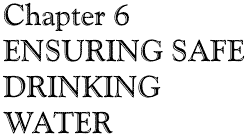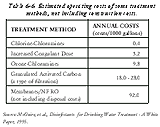
| ch. 6, pp. 83 - 84 |
If desalting is the preferred choice, the costs of disposing of the brine can be high. For desalting systems on sea coasts, this is not a problem. The brine is usually dumped in the ocean, which is a convenient and inexpensive solution to the problem. For land-locked places such as Tucson, however, no easy solution exists. The brine can be evaporated and the solid matter landfilled or it can be piped elsewhere as brine. In either case, between 15 and 35 percent of the water is lost, increasing water costs. Shipping the brine elsewhere would involve building a pipeline almost as long as the CAP canal itself to the Gulf of California or the Colorado River. While a federal subsidy is possible, it is not likely. If the salts are landfilled, either a new landfill for that purpose must be built or existing landfills would soon fill up.
New landfills then would be needed sooner than previously expected – a cost to taxpayers, not to water rate payers. Landfilling in established landfills is not currently considered as an option for various reasons including landfill space and problems of the dried salts becoming airborne. Although providing specific treatment costs is not possible, voters and elected officials need estimates of cost for various alternatives before choosing a water treatment method. One study found the costs of NF and RO are 10 times higher than the costs of ozone- chloramine treatment, even without considering the costs of brine disposal. According to this study the use of membranes could raise the typical residential water bill by $100 per year or more above the cost of ozone-chloramines. Decision makers should also compare the costs of not desalinating with the costs of desalinating; e.g. what will it cost consumers to replace water fixtures or appliances that accumulate scale or corrode? What will consumers have to pay to leach salts from landscapes or to buy home treatment systems or bottled water? If CAP water is to be part of the total Tucson water picture, Tucson decision makers need to determine how to deal with the water quality problems listed above. Some of the issues they need to confront are:
While decisions about specific treatment methods may be highly technical and best left to professionals, local residents need to express opinions about the levels of treatment they prefer and what they are willing to pay for CAP water.
|

